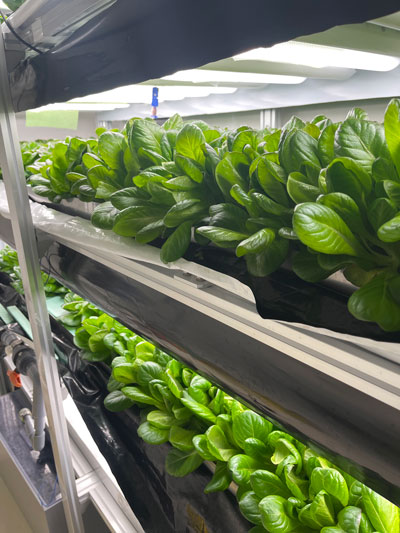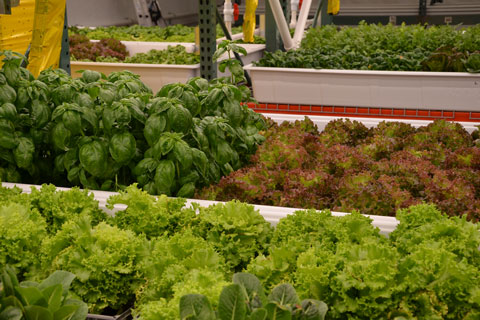11/1/2022
Answering Key Questions About Indoor Crops
Chieri Kubota, Erik Runkle, Cary Mitchell & Roberto Lopez
Indoor farming is the production of high-value crops inside repurposed or purpose-built buildings or containers using sole-source lighting. This emerging agricultural sector continues to expand in the U.S. and beyond. In this series of articles, OptimIA (optimizing indoor agriculture) project members answer frequently asked questions. Here, we address questions relating to the production of leafy greens within vertical farms with controlled environments. More information about our project is available at
scri-optimia.org.
Q: What crops are well suited to indoor farming?
A: The answer to this question is somewhat situational. However, crops that are excellent candidates for indoor production usually have most or all of these characteristics:
• The production cycle is short
• The harvestable yield (the portion of the plant that’s marketable) is high
• Plants have a compact growth habit
• There’s year-round demand
• Production can be (semi-) automated
• The product is perishable
• Plant quality and yield are sufficiently high under low to moderate daily light integral
• The crop value is relatively high
Leafy greens, herbs and young plants are excellent candidate crops for indoor production because they fit many of these categories.
Q: What’s the recommended plant density for lettuce and basil?
A: For head-forming lettuces (typical production cycle of ~6 weeks after seeding), final plant density is typically between three to five plants per square foot (30 to 45 plants per square meter). A planting density in this range (44 plants per square meter) can be achieved when plants are growing in 6-in. (~15-cm) spacing for example. For mini-head lettuce, the crop cycle is shorter (four to five weeks) and the plant density can be six to seven times higher. For basil, the plant density can be at least three to four times greater than that for head-forming lettuce because of the plant architecture with smaller leaves and longer internodes.
 Figure 1. High-density indoor production of lettuce.
Figure 1. High-density indoor production of lettuce.
Planting density is an important parameter that affects productivity, revenue and production costs. High density production can increase the yield per production space (Figure 1), but requires more operational expenses, such as seeds and substrates. Typically, young seedlings are initially grown at a much higher density (e.g., 700 to 1,000 plants per square meter) and transplanted to the production area at a final density mentioned above for lettuce and basil. In some cases, an intermediate spacing is used at this first transplanting and one more re-spacing is conducted to the final plant density in the middle of the production cycle. Optimization of planting density is important for space and light utilization, and to increase profitability.
Q: What’s the typical time to harvest from seed sow for lettuce and basil?
A: Several environmental factors will influence the size and production time of crops, including temperature, light intensity, quality and duration, and carbon dioxide concentration. Additionally, your market may dictate the size of plants that you need to achieve. The type of lettuce (i.e., butterhead or leaf) will also have an effect. Temperature has a strong influence on the rate of plant development, including the rate of germination, rooting, leaf unfolding and flowering, with different crops having specific temperature ranges conducive for development. Our research at Michigan State University has recently determined that the temperature at which development stops, also known as the base (Tb) and the optimum temperatures (Topt) for red oakleaf lettuce fresh mass accumulation is (Tb 47.3F [8.5C], Topt 79.2F [26.2C]) and green butterhead lettuce (Tb 47.2F [8.4C], Topt 76.3F [24.7C]).
Under optimum conditions, time to harvest from seed sow is often four to six weeks for lettuce and basil, respectively. Growers of baby greens may harvest plants after 18 to 24 days from seed sow. Basil can be harvested a couple of times from the same plant and the time to the second cut is typically shorter (~2 weeks after the first cut).
Q: What risks or challenges can occur when crops (i.e., basil and lettuce) with different environmental and/or cultural responses are grown under the same conditions?
A: All crops will grow to some extent under the same environmental conditions maintained throughout a warehouse, but will yield and quality for all of them be acceptable, and will different crops being grown simultaneously in the same environment all be profitable?
Of the five cardinal factors required for successful indoor crop production (light, temperature, water, nutrients and atmosphere), optimum environmental combinations likely will differ widely among crops, and developing true optimum growth recipes still is very much a research question in progress for most crops.
For example, optimum temperatures for basil and lettuce are distinctly different [by as much as 9F (5C)], and some basil cultivars also respond favorably to increased light intensity, whereas elevated light intensities likely would be considered wasteful for lighting lettuce, with its narrow profit margin so sensitive to energy costs.
Of course, light intensity and spectrum are among the few environmental parameters that can be customized on different shelves or tiers of vertical farms. On the other hand, parameters such as ambient temperature and CO2 concentration would be harder to control separately per crop without some kind of compartmentalization (partitions or rooms) within the building. Different types of water and nutrient delivery also are possible for different crop types within the same indoor farm, but this will entail additional expense and technical complexity.
 Figure 2. Production of basil and lettuce within the same growing area can pose challenges, as each crop has its own unique environmental responses.
Figure 2. Production of basil and lettuce within the same growing area can pose challenges, as each crop has its own unique environmental responses.
Have basil and lettuce been grown together under the same compromise environments in an indoor farm? Yes, they have, but the dominant growth environment used usually is that of the dominant crop grown for local market demand (usually lettuce), and the secondary crop (e.g., basil) usually languishes somewhat in terms of productivity and quality (Figure 2). Indoor farms that wish to diversify and will have multiple crops with significantly different growth recipes probably should design for the best growth environments they can provide for each crop, and if they can’t afford to do that, probably should consider restricting their crop choices to the range of what they can reliably afford to control at the time!
Q: What are some of the more challenging crops or crops to avoid for indoor production?
A: Generally, crops that require high-light intensities, have long production cycles, require manual pruning and harvesting, and have a small harvest index (a ratio of marketable biomass over total biomass) are challenging to grow indoors from an economics perspective. This includes tall-stature plants and many agricultural commodity crops.
For example, corn has a long production cycle, a low harvestable yield and occupies a lot of space, especially vertically. In addition, the economic value of a crop (an ear or bushel of corn) is relatively low. Other factors to consider when deciding which crops to grow indoors include the year-round local supply and demand, and prices and qualities of crops that are grown in the field, high tunnels or greenhouses, or are imported from other countries.
Q: What pests and pathogens pose the greatest financial impact to the production of crops in indoor farms? How is control maintained?
A: Environmental conditions in indoor farms are good for plant growth, as well as horticulture pests (arthropods) and pathogens. Common pests include aphids, fungus gnats, thrips, whiteflies and spider mites. Common plant pathogens include powdery mildew, downy mildew and Pythium root rot.
Entry points can be air intake for ventilation if the facility is designed to have some ventilation (air exchanges). If the entry points aren’t adequately monitored and controlled, young plants and workers can introduce pests. Human access in the production room should be minimized and workers need to take strict hygiene measures to ensure they aren’t introducing pests and pathogens.
For example, installing air showers, wearing coverall suits (or lab coats with pants and shoe covers), washing hands and sanitizing feet or changing shoes at the entrance to the production room is recommended. For planting materials, seeds are preferred starting materials to bring into the clean environment; as they can be surface sterilized more easily than transplants (young plants). However, indoor farms for vegetatively propagated crops such as strawberry or crops that require specialized transplants such as grafted plants may need to consider this critical control point to mitigate the risk of introducing pests and diseases. IG
For More FAQs | To see the first two articles in the series, visit inside-grower.com and click on Magazine Archives in the drop-down menu. The first two were in the May 2022 and August 2022 issues.
Chieri Kubota is a Professor and Director at Ohio Controlled Environment Agriculture Center (OHCEAC), The Ohio State University. Erik Runkle is a Professor and Extension Specialist in the Department of Horticulture at Michigan State University. Cary Mitchell is a Professor in the Department of Horticulture and Landscape Architecture at Purdue University. Roberto Lopez is an Associate Professor and Controlled Environment/Floriculture Extension Specialist in the Department of Horticulture at Michigan State University. This project is supported by USDA-NIFA Specialty Crop Research Initiative (SCRI) award no. 2019-51181-30017.